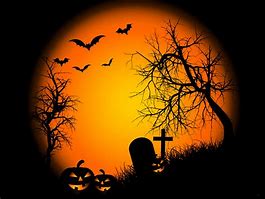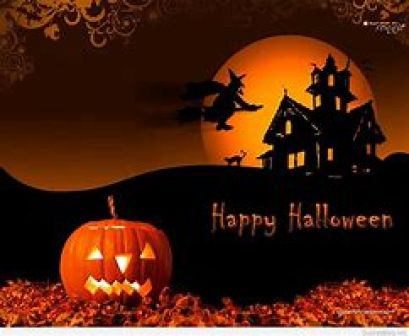 Halloween means “All Hallows’ Eve” Allhallowe’en or All Saints’ Eve celebrated on 31st October, the eve of the Western Christian feast of All Hallows’ Day and for traditionalists it begins a 3-day observance of Allhallowtide or a time of remembering the dead, including saints (hallows), martyrs, and all the loved ones passed over.
Halloween means “All Hallows’ Eve” Allhallowe’en or All Saints’ Eve celebrated on 31st October, the eve of the Western Christian feast of All Hallows’ Day and for traditionalists it begins a 3-day observance of Allhallowtide or a time of remembering the dead, including saints (hallows), martyrs, and all the loved ones passed over.
It is widely believed that many Halloween traditions originated from ancient Celtic harvest festivals, particularly the Gaelic festival Samhain which was absorbed into Christianity as Halloween by the early Church.
Interesting because when I was living in America and married to a born-again Christian who worried my soul was doomed if I didn’t get “saved” I had to listen to a Pastor rail against Halloween for almost the entire service. He warned us if we participated we would almost certainly risk hell. This sour nonsense was followed by what I can only describe as an episode of truly bone-chilling “talking in tongues” from some woman in the front pew whose entire body arched backwards as she spewed forth this garbled rhetoric that was later translated as a warning from God, you guessed it, dissing Halloween.
But how dangerous can Halloween be with diabolical activities like door-to-door trick-or-treating, carving pumpkins into jack-o’-lanterns, dressing up in costume and watching the umpteenth repeat of The Addams Family Values (my preferred Halloween viewing)?
In answer to the revved up Christian Pastor at that Church in Seattle in 1997 the word Halloween or Hallowe’en dates back to 1745 and is of Christian origin. It means “hallowed evening” or “holy evening” and comes from a Scottish term for All Hallows’ Eve. So it’s a pity the Pastor didn’t do his homework instead of ruining some harmless fun planned by the kids and a few of the big kids like me.
To quote from Wikipedia
“History
Gaelic and Welsh influence
An early 20th-century Irish Halloween mask displayed at the Museum of Country Life.
Today’s Halloween customs are thought to have been influenced by folk customs and beliefs from the Celtic-speaking countries, some of which are believed to have pagan roots. Jack Santino, a folklorist, writes that “there was throughout Ireland an uneasy truce existing between customs and beliefs associated with Christianity and though associated with religions that were Irish before Christianity arrived”. Historian Nicholas Rogers, exploring the origins of Halloween, notes that while “some folklorists have detected its origins in the Roman feast of Pomona, the goddess of fruits and seeds, or in the festival of the dead called Parentalia, it is more typically linked to the Celtic festival of Samhain, which comes from the Old Irish for ‘summer’s end’.”
Samhain was the first and most important of the four quarter days in the medieval Gaelic calendar and was celebrated on 31 October – 1 November in Ireland, Scotland and the Isle of Man. A kindred festival was held at the same time of year by the Brittonic Celts, called Calan Gaeaf in Wales, Kalan Gwav in Cornwall and Kalan Goañv in Brittany; a name meaning “first day of winter”. For the Celts, the day ended and began at sunset; thus the festival began on the evening before 7 November by modern reckoning (the half point between equinox and solstice). Samhain and Calan Gaeaf are mentioned in some of the earliest Irish and Welsh literature. The names have been used by historians to refer to Celtic Halloween customs up until the 19th century, and are still the Gaelic and Welsh names for Halloween. Samhain/Calan Gaeaf marked the end of the harvest season and beginning of winter or the ‘darker half’ of the year. Like Beltane/Calan Mai, it was seen as a liminal time, when the boundary between this world and the Otherworld thinned. This meant the Aos Sí the ‘spirits’ or ‘fairies’, could more easily come into this world and were particularly active. The souls of the dead were also said to revisit their homes seeking hospitality. Places were set at the dinner table and by the fire to welcome them. The belief that the souls of the dead return home on one night of the year seems to have ancient origins and is found in many cultures throughout the world. In 19th century Ireland, “candles would be lit and prayers formally offered for the souls of the dead. After this the eating, drinking, and games would begin”.

From at least the 16th century, the festival included mumming and guising in Ireland, Scotland, the Isle of Man and Wales. This involved people going house-to-house in costume (or in disguise), usually reciting verses or songs in exchange for food. Elsewhere in Europe, mumming and hobby horses were part of other yearly festivals. However, in the Celtic-speaking regions they were “particularly appropriate to a night upon which supernatural beings were said to be abroad and could be imitated or warded off by human wanderers”.
On All Hallows’ Eve, Christians in some parts of the world visit cemeteries to pray and place flowers and candles on the graves of their loved ones.
It has been suggested that the carved jack-o’-lantern, a popular symbol of Halloween, originally represented the souls of the dead. On Halloween, in medieval Europe, fires served a dual purpose, being lit to guide returning souls to the homes of their families, as well as to deflect demons. Households in Austria, England and Ireland often had “candles burning in every room to guide the souls back to visit their earthly homes”. These were known as “soul lights”. Many Christians in mainland Europe, especially in France, believed “that once a year, on Hallowe’en, the dead of the churchyards rose for one wild, hideous carnival” known as the danse macabre.
“In Cajun areas, a nocturnal Mass was said in cemeteries on Halloween night. Candles that had been blessed were placed on graves, and families sometimes spent the entire night at the graveside”.
The Church seems to have developed a real fear of this harmless and rather delightful tradition. I think it’s lovely to believe the veil between worlds thins for at least one night of the year and the bonds of love can be acknowledged and forged between the caretakers of the this world and the inevitable next. I will be wearing my usual horns and welcoming all the little ghosts and ghoulies and witches in my neighbourhood with chocolate crackles and mini-flakes.
Happy Halloween All!

Put a spell on you!






Exceptional musings on a truly wonderful blog! Fantastic!
LikeLike
Thank you so much. I love your poetry! Have re-blogged one as you know.
LikeLiked by 1 person
I’m very honored. It means a great deal to me, Wendy. Thanks again. And, my sincere pleasure.
LikeLiked by 1 person